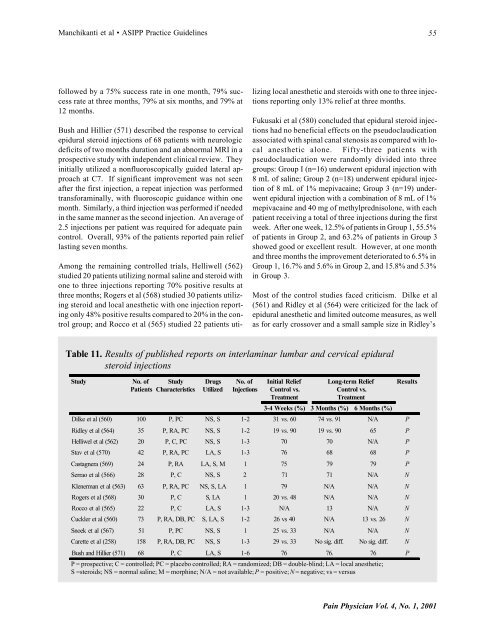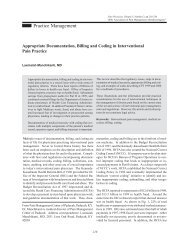ASIPP Practice Guidelines - Pain Physician
ASIPP Practice Guidelines - Pain Physician
ASIPP Practice Guidelines - Pain Physician
Create successful ePaper yourself
Turn your PDF publications into a flip-book with our unique Google optimized e-Paper software.
Manchikanti et al • <strong>ASIPP</strong> <strong>Practice</strong> <strong>Guidelines</strong><br />
55<br />
followed by a 75% success rate in one month, 79% success<br />
rate at three months, 79% at six months, and 79% at<br />
12 months.<br />
Bush and Hillier (571) described the response to cervical<br />
epidural steroid injections of 68 patients with neurologic<br />
deficits of two months duration and an abnormal MRI in a<br />
prospective study with independent clinical review. They<br />
initially utilized a nonfluoroscopically guided lateral approach<br />
at C7. If significant improvement was not seen<br />
after the first injection, a repeat injection was performed<br />
transforaminally, with fluoroscopic guidance within one<br />
month. Similarly, a third injection was performed if needed<br />
in the same manner as the second injection. An average of<br />
2.5 injections per patient was required for adequate pain<br />
control. Overall, 93% of the patients reported pain relief<br />
lasting seven months.<br />
Among the remaining controlled trials, Helliwell (562)<br />
studied 20 patients utilizing normal saline and steroid with<br />
one to three injections reporting 70% positive results at<br />
three months; Rogers et al (568) studied 30 patients utilizing<br />
steroid and local anesthetic with one injection reporting<br />
only 48% positive results compared to 20% in the control<br />
group; and Rocco et al (565) studied 22 patients utilizing<br />
local anesthetic and steroids with one to three injections<br />
reporting only 13% relief at three months.<br />
Fukusaki et al (580) concluded that epidural steroid injections<br />
had no beneficial effects on the pseudoclaudication<br />
associated with spinal canal stenosis as compared with local<br />
anesthetic alone. Fifty-three patients with<br />
pseudoclaudication were randomly divided into three<br />
groups: Group I (n=16) underwent epidural injection with<br />
8 mL of saline; Group 2 (n=18) underwent epidural injection<br />
of 8 mL of 1% mepivacaine; Group 3 (n=19) underwent<br />
epidural injection with a combination of 8 mL of 1%<br />
mepivacaine and 40 mg of methylprednisolone, with each<br />
patient receiving a total of three injections during the first<br />
week. After one week, 12.5% of patients in Group 1, 55.5%<br />
of patients in Group 2, and 63.2% of patients in Group 3<br />
showed good or excellent result. However, at one month<br />
and three months the improvement deteriorated to 6.5% in<br />
Group 1, 16.7% and 5.6% in Group 2, and 15.8% and 5.3%<br />
in Group 3.<br />
Most of the control studies faced criticism. Dilke et al<br />
(561) and Ridley et al (564) were criticized for the lack of<br />
epidural anesthetic and limited outcome measures, as well<br />
as for early crossover and a small sample size in Ridley’s<br />
Table 11. Results of published reports on interlaminar lumbar and cervical epidural<br />
steroid injections<br />
Study<br />
No. of<br />
Patients<br />
Study<br />
Characteristics<br />
Drugs<br />
Utilized<br />
No. of<br />
Injections<br />
Initial Relief<br />
Control vs.<br />
Treatment<br />
Long-term Relief<br />
Control vs.<br />
Treatment<br />
3-4 Weeks (%) 3 Months (%) 6 Months (%)<br />
Dilke et al (560) 100 P, PC NS, S 1-2 31 vs. 60 74 vs. 91 N/A P<br />
Ridley et al (564) 35 P, RA, PC NS, S 1-2 19 vs. 90 19 vs. 90 65 P<br />
Helliwel et al (562) 20 P, C, PC NS, S 1-3 70 70 N/A P<br />
Stav et al (570) 42 P, RA, PC LA, S 1-3 76 68 68 P<br />
Castagnera (569) 24 P, RA LA, S, M 1 75 79 79 P<br />
Serrao et al (566) 28 P, C NS, S 2 71 71 N/A N<br />
Klenerman et al (563) 63 P, RA, PC NS, S, LA 1 79 N/A N/A N<br />
Rogers et al (568) 30 P, C S, LA 1 20 vs. 48 N/A N/A N<br />
Rocco et al (565) 22 P, C LA, S 1-3 N/A 13 N/A N<br />
Cuckler et al (560) 73 P, RA, DB, PC S, LA, S 1-2 26 vs 40 N/A 13 vs. 26 N<br />
Snoek et al (567) 51 P, PC NS, S 1 25 vs. 33 N/A N/A N<br />
Carette et al (258) 158 P, RA, DB, PC NS, S 1-3 29 vs. 33 No sig. diff. No sig. diff. N<br />
Bush and Hillier (571) 68 P, C LA, S 1-6 76 76. 76 P<br />
P = prospective; C = controlled; PC = placebo controlled; RA = randomized; DB = double-blind; LA = local anesthetic;<br />
S =steroids; NS = normal saline; M = morphine; N/A = not available; P = positive; N = negative; vs = versus<br />
Results<br />
<strong>Pain</strong> <strong>Physician</strong> Vol. 4, No. 1, 2001
















